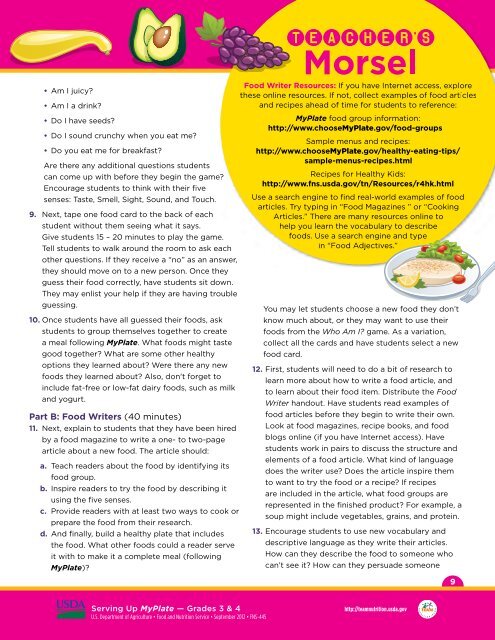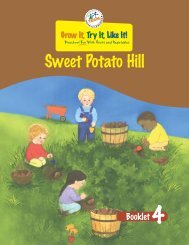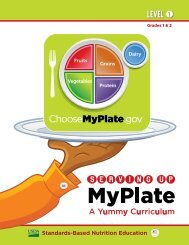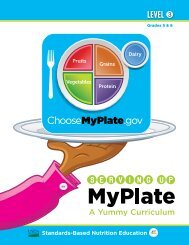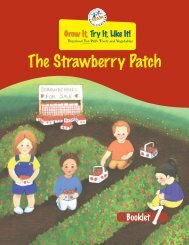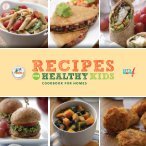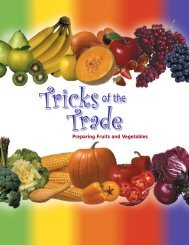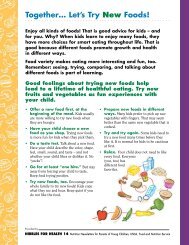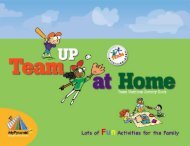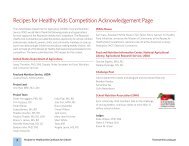Serving Up MyPlate-A Yummy Curriculum, Level 2 - Team Nutrition ...
Serving Up MyPlate-A Yummy Curriculum, Level 2 - Team Nutrition ...
Serving Up MyPlate-A Yummy Curriculum, Level 2 - Team Nutrition ...
Create successful ePaper yourself
Turn your PDF publications into a flip-book with our unique Google optimized e-Paper software.
• Am I juicy?<br />
• Am I a drink?<br />
• Do I have seeds?<br />
• Do I sound crunchy when you eat me?<br />
• Do you eat me for breakfast?<br />
Are there any additional questions students<br />
can come up with before they begin the game?<br />
Encourage students to think with their five<br />
senses: Taste, Smell, Sight, Sound, and Touch.<br />
9. Next, tape one food card to the back of each<br />
student without them seeing what it says.<br />
Give students 15 – 20 minutes to play the game.<br />
Tell students to walk around the room to ask each<br />
other questions. If they receive a “no” as an answer,<br />
they should move on to a new person. Once they<br />
guess their food correctly, have students sit down.<br />
They may enlist your help if they are having trouble<br />
guessing.<br />
10. Once students have all guessed their foods, ask<br />
students to group themselves together to create<br />
a meal following <strong>MyPlate</strong>. What foods might taste<br />
good together? What are some other healthy<br />
options they learned about? Were there any new<br />
foods they learned about? Also, don't forget to<br />
include fat-free or low-fat dairy foods, such as milk<br />
and yogurt.<br />
Part B: Food Writers (40 minutes)<br />
11. Next, explain to students that they have been hired<br />
by a food magazine to write a one- to two-page<br />
article about a new food. The article should:<br />
a. Teach readers about the food by identifying its<br />
food group.<br />
b. Inspire readers to try the food by describing it<br />
using the five senses.<br />
c. Provide readers with at least two ways to cook or<br />
prepare the food from their research.<br />
d. And finally, build a healthy plate that includes<br />
the food. What other foods could a reader serve<br />
it with to make it a complete meal (following<br />
<strong>MyPlate</strong>)?<br />
You may let students choose a new food they don’t<br />
know much about, or they may want to use their<br />
foods from the Who Am I? game. As a variation,<br />
collect all the cards and have students select a new<br />
food card.<br />
12. First, students will need to do a bit of research to<br />
learn more about how to write a food article, and<br />
to learn about their food item. Distribute the Food<br />
Writer handout. Have students read examples of<br />
food articles before they begin to write their own.<br />
Look at food magazines, recipe books, and food<br />
blogs online (if you have Internet access). Have<br />
students work in pairs to discuss the structure and<br />
elements of a food article. What kind of language<br />
does the writer use? Does the article inspire them<br />
to want to try the food or a recipe? If recipes<br />
are included in the article, what food groups are<br />
represented in the finished product? For example, a<br />
soup might include vegetables, grains, and protein.<br />
13. Encourage students to use new vocabulary and<br />
descriptive language as they write their articles.<br />
How can they describe the food to someone who<br />
can’t see it? How can they persuade someone<br />
<strong>Serving</strong> <strong>Up</strong> <strong>MyPlate</strong> — Grades 3 & 4 http://teamnutrition.usda.gov<br />
U.S. Department of Agriculture • Food and <strong>Nutrition</strong> Service • September 2012 • FNS-445<br />
9


